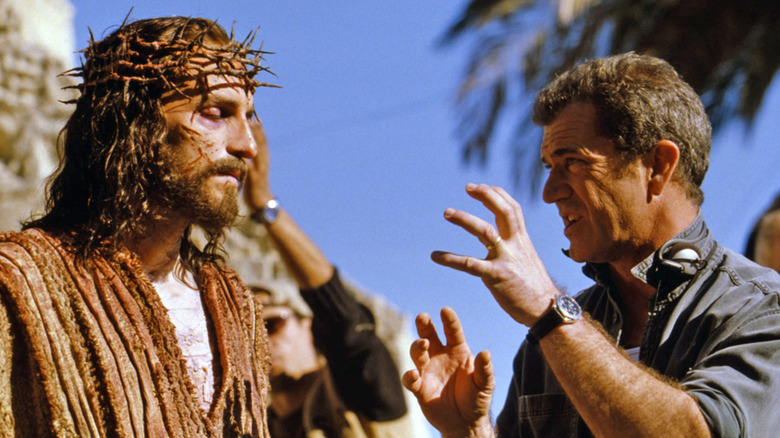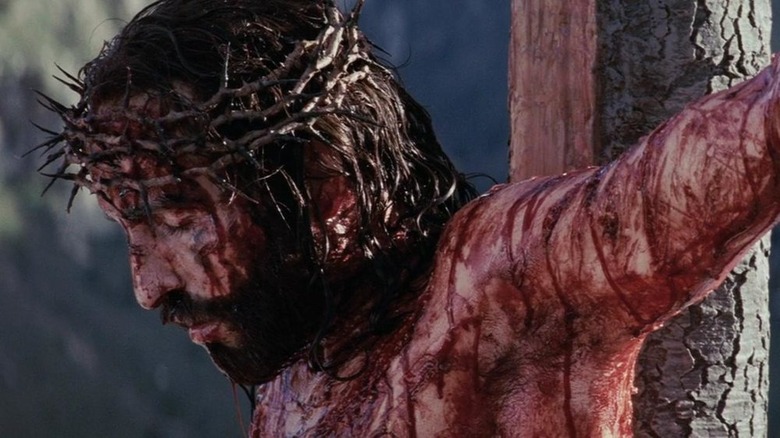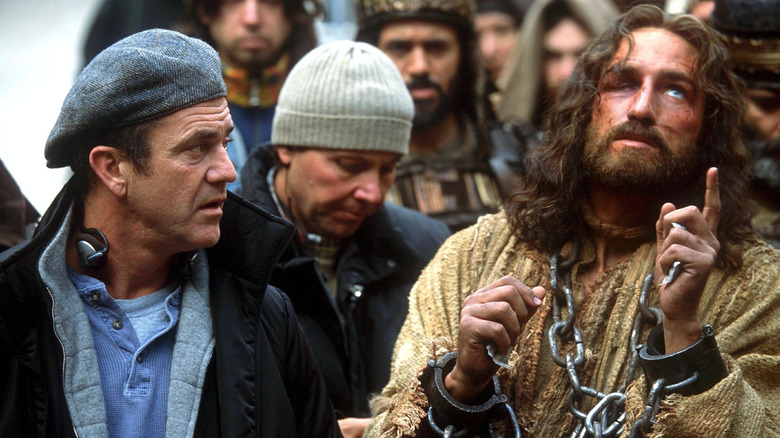The Passion Of The Christ Controversy Explained

When "The Passion of the Christ" was released on Ash Wednesday in February 2004, the reaction was overwhelming. Directed by Mel Gibson and starring Jim Caviezel, "The Passion of the Christ" presented itself as an authentic and unflinching examination of Jesus' sacrifice told in Hebrew, Latin, and Aramaic languages. It became a massive box office hit, accumulating over $600 million. At the time, it was the highest-grossing R-rated release. "The Passion of the Christ" received tremendous support from the Christian community, particularly because of a marketing campaign that provided guides to church leaders about integrating the film's themes into their education initiatives and preaching.
Despite this booming success amongst evangelicals, critics' reactions were fairly mixed. New York Post reviewer Lou Lumenick called the film "an impressive, ultra-violent — and deeply troubling — take on Jesus' final hours." Although Gibson's cinematic passion play was well-received by the religious, many were concerned about its "deeply troubling" elements.
There Was Graphic Violence

"The Passion of the Christ" depicts the brutality of Jesus' crucifixion — the whipping, the nailing to the cross, the piercing crown of thorns — with explicit horror. Its less Biblical epic and more torture porn akin to the "Saw" movies. Distinguished Robert Ebert critic deemed Gibson's lurid drama "the most violent film I have ever seen." Over-the-top reactions to the film's garish voyeurism from the audience became synonymous with its exhibition. With nearly two plus hours of continuous bloody violence, there were many notorious instances of people driven to uncontrollable tears, fainting, and even suffering heart attacks. Many found the graphic nature of the torture scenes to be incredibly off-putting and sadistic. The flogging scene depicts Roman soldiers gleefully ripping off Christ's flesh a mind-boggling total of 96 times, /Film writer Joshua Meyer counts in his phenomenal essay on "The Passion of the Christ" at 15 years old. "Is the endless succession of blows meant to be a visual expression of every sin he's ever felt, every betrayal, from every person throughout human history? Or is it meant to be more literal, more tangible, less metaphysical, than that?" Meyer wonders. Gibson seems to revel in the unremitting cruelty to depict how acutely Jesus suffered for our sins. This excessive and relentless brutality also reflects the Christian obsessions with martyrdom and suffering.
In 2005, Gibson released a re-cut version that removed five minutes of the most harrowing savagery in order to appeal to families. He released the following statement:
"After the initial run in movie theaters, I received numerous letters from people all across the country. Many told me they wanted to share the experience with loved ones but were concerned that the harsher images of the film would be too intense for them to bear. In light of this, I decided to re-edit 'The Passion of the Christ.'"
Mel Gibson Was Accused Of Antisemitism

Content warning: Descriptions of antisemitic imagery and language.
"The Passion of the Christ" was also criticized for its blatant antisemitism, an accusation that Gibson was no stranger to. He was raised as a traditionalist, an extremist Catholic sect that rejects the modernization of the church — a change that Gibson's Holocaust-denying father believed was an evil plot orchestrated by the Jewish people. In 1996, Gibson reportedly asked Winona Ryder if she was an "oven-dodger" while attending a party.
After Gibson's company Icon Productions financially backed "The Passion of the Christ," he had trouble finding distribution; many were disturbed by the antisemitic content found in early readings of the script — made worse in its final production. According to the Los Angeles Times, politician Dov Hikind insisted the film "will result in antisemitism and bigotry. It really takes us back to the Dark Ages." The Journal of Religion in Film records the statement made by the ADL and U.S. Conference of Catholic Bishops: "[It is] one of the most troublesome texts, relative to antisemitic potential, that any of us had seen in 25 years." They believed that Gibson would "falsify history and fuel the animus of those who hate Jews." These protestations caused 20th Century Fox to pass on distributing the film. In order to avoid any other studios turning it down, Gibson distributed "The Passion of the Christ" himself with the aid of Newmarket Films.
Antisemitism appears throughout the final film in its cartoonish depiction of Jewish people. The lavishly-dressed Jewish characters are othered as evil, scheming misers hungry for Christ's blood. The National Catholic Reporter argues that Gibson frames "the Jewish leaders as a soulless mafia, the apostles and Jesus as outside of Jewish religious life, and the Jewish people as unanimously involved in eagerly seeing Jesus tortured and murdered." Gibson blatantly perpetuates racial stereotypes; at one point, Jami Bernard notes in Today, he "cuts from the hook nose of one bad Jewish character to the hook nose of another in the ensuing scene." Bernard asserts that Gibson's film "is the most virulently antisemitic movie since the German propaganda films of World War Two."
The most damning scene is when the Jewish high priest Caiaphas states that "his blood [is] on us and on our children," a line from the Gospel of Matthew that blames the Jewish community for Jesus' death. Gibson claims he interprets this line as directed toward all humanity. Despite pleas to remove this line, he vehemently refused — his obstinate insistence clearly driven by a need to proselytize his hateful beliefs. Gibson's antisemitism did not end with "The Passion of the Christ." In 2006, he was caught driving while intoxicated and went on a random racist rant insisting that "Jews are responsible for all the wars in the world." In light of this behavior, it is difficult not to read "The Passion of the Christ" as a fundamentally antisemitic work, regardless of its financial success and popularity amongst the Christian community.
Read this next: The Best Movies Of 2021 So Far
The post The Passion of the Christ Controversy Explained appeared first on /Film.
from /Film https://ift.tt/31jSqtB
No comments: